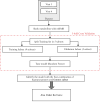Serum Metabolites Relate to Mucosal and Transmural Inflammation in Paediatric Crohn Disease
- PMID: 38842257
- PMCID: PMC11532621
- DOI: 10.1093/ecco-jcc/jjae085
Serum Metabolites Relate to Mucosal and Transmural Inflammation in Paediatric Crohn Disease
Abstract
Background and aims: We aimed to identify serum metabolites associated with mucosal and transmural inflammation in paediatric Crohn disease [pCD].
Methods: In all, 56 pCD patients were included through a pre-planned sub-study of the multicentre, prospective, ImageKids cohort, designed to develop the Paediatric Inflammatory Crohn magnetic resonance enterography [MRE] Index [PICMI]. Children were included throughout their disease course when undergoing ileocolonoscopy and MRE and were followed for 18 months, when MRE was repeated. Serum metabolites were identified using liquid chromatography/mass spectroscopy. Outcomes included: PICMI, the simple endoscopic score [SES], faecal calprotectin [FCP], and C-reactive protein [CRP], to assess transmural, mucosal, and systemic inflammation, respectively. Random forest models were built by outcome. Maximum relevance minimum redundancy [mRMR] feature selection with a j-fold cross-validation scheme identified the best subset of features and hyperparameter settings.
Results: Tryptophan and glutarylcarnitine were the top common mRMR metabolites linked to pCD inflammation. Random forest models established that amino acids and amines were among the most influential metabolites for predicting transmural and mucosal inflammation. Predictive models performed well, each with an area under the curve [AUC] > 70%. In addition, serum metabolites linked with pCD inflammation mainly related to perturbations in the citrate cycle [TCA cycle], aminoacyl-tRNA biosynthesis, tryptophan metabolism, butanoate metabolism, and tyrosine metabolism.
Conclusions: We extend on recent studies, observing differences in serum metabolites between healthy controls and Crohn disease patients, and suggest various associations of serum metabolites with transmural and mucosal inflammation. These metabolites could improve the understanding of pCD pathogenesis and assessment of disease severity.
Keywords: Serum metabolites; machine learning; paediatric Crohn disease.
© The Author(s) 2024. Published by Oxford University Press on behalf of European Crohn’s and Colitis Organisation.
Conflict of interest statement
RS, NG, GT, ZZ, DM, DW, VMN, SK, OL, and BN have no conflict to disclose in relation to the content of this manuscript. GF reports consultation fees from Abbvie and Lilly. AMG reports consultant fees from Abbvie, Amgen, Bristol Myers Squibb, Lilly, Janssen, Merck, Pfizer; speaker fees from Abbvie, Janssen, Nestlé; investigator-initiated research grant from Abbvie. LdR received personal fees, consultation and congress support from Shire, Malinckrodt, Nestlé, Celltrion, Merck, Janssen biologics, Abbvie, and Pfizer. KG has received research grants and speaker fees from Nestle Health Sciences, Nutricia-Danone, Baxter, Mylan. DT reports consultation fee, research grant, royalties, or honorarium from Janssen, Pfizer, Hospital for Sick Children, Ferring, Abbvie, Takeda, Atlantic Health, Shire, Celgene, Lilly, Roche, ThermoFisher, BMS. EW reports personal fees from AbbVie, Janssen, Nestle Health Sciences, BioJamp, Pfizer, and Mead Johnson Nutrition.
Figures








References
-
- Ng SC, Shi HY, Hamidi N, et al.. Worldwide incidence and prevalence of inflammatory bowel disease in the 21st century: a systematic review of population-based studies. Lancet 2017;390:2769–78. - PubMed
-
- Vernier–Massouille G, Balde M, Salleron J, et al.. Natural history of paediatric Crohn’s disease: a population-based cohort study. Gastroenterology 2008;135:1106–13. - PubMed
-
- Blacher E, Levy M, Tatirovsky E, Elinav E.. Microbiome-modulated metabolites at the interface of host immunity. J Immunol 2017;198:572–80. - PubMed
-
- Kolho KL, Pessia A, Jaakkola T, de Vos WM, Velagapudi V.. Faecal and serum metabolomics in paediatric inflammatory bowel disease. J Crohns Colitis 2016;11:321–34. - PubMed
Publication types
MeSH terms
Substances
Supplementary concepts
Grants and funding
LinkOut - more resources
Full Text Sources
Medical
Research Materials
Miscellaneous

